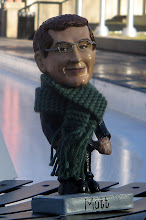This is the fourth post on the audition wisdom of Thomas Freer (TF), assistant principal timpanist and section percussionist in the Cleveland Orchestra. TF has developed a unique and practical method of audition preparation, which he explained in two seminars at this summer’s Kent Blossom Music Festival, and which I’ve tried to summarize here. If you’d like to catch up you can read the previous post, or jump back to part I.
The beauty of TF’s approach is that, by practicing the audition as realistically as possible, the event itself will seem familiar and ordinary. This is not to say that auditions will become boring - the excitement and energy should come from the music, not from anxiety about what it will feel like to walk on stage and play to a screen. A few pieces of practical advice from TF may help keep the day of the audition even more comfortable and focused.
1. Be self-sufficient
Sometimes the waiting at an audition can be as stressful as the playing - you can also prepare to wait, though, and bring whatever provisions you may need - food, water, reading material, etc. You often may have limited opportunities to leave the audition site during the day, and it might be preferable to stay in any case. Being ready to wait will give you the flexibility to focus on one round at a time.
2. Be friendly, but don’t treat it as a social function
It is easy to get involved in long catch-up conversations with other players at an audition - your first priority, though, is to win the job, not to network. You don’t need to stonewall your friends - just say, “Great to see you - let’s catch up later - now I’ve got to get ready.” If you are playing late in a round, which TF recommends you try to do - see below - you may actually be able to quiz your friends. Ask what they played, how the hall responded, what they were asked to play differently. The list will almost always remain the same throughout the round, and if you ask the right questions (and your friends answer honestly!) you can gain a lot of useful information this way.
3. Be ready, but don’t be early
Getting plenty of sleep, a good breakfast, and a thorough warm-up - these are all common wisdom for any important performance. An audition is one performance, though, in which it may not be to your advantage to show up a half-hour before you are expected. In fact, TF suggests showing up 45 minutes late if you are given an early time in a cattle call audition - you can always make a plausible excuse, and get to play later in the round. This will give you more time to look at the list, which is frequently announced just before the first candidate plays. Later players also benefit from a panel which has heard a lot of people and has learned what to expect and where to focus.
4. Be assertive and responsive in repeating excerpts
If something goes wrong, and you know you can play an excerpt much better, don’t be afraid to ask to play it again. Even if the proctor is resistant, the panel will usually be happy to hear you - as long as they can hear a difference. Likewise, if the panel instructs you to repeat an excerpt with a different tempo or character, be ready to make a demonstrable difference. You can test yourself at this in your mock auditions - have your panelists give you an instruction, and play it back to see if you really made the change.
While you want to be adaptable and attentive to anything the panel says, don’t read too much into it - it doesn’t mean you screwed up, they may just be trying to see how responsive you will be. Just like in your mock auditions, you need to rely on your own observations and quality control, and play to your own ideals. Of course, the more thoroughly you’ve prepared and learned the excerpts, the better you’ll be able to present a convincing interpretation, as well as to adjust when asked.
5. Be single-minded, and single-pointed
One last bit of intriguing advice - TF mentioned how when Tiger Woods prepares his golf swing, he doesn’t look all around. His vision pattern follows an extremely simple path - ball, hole, ball, hole, etc. We don’t have quite as clear and visible a target to aim for, but if we focus our vision on a single point, and move our eyes slowly between points, we can often calm and quiet our scattered thoughts.
Many thanks to Tom Freer for all his help and advice, and thanks and congratulations to any readers who managed to navigate through my first serialized posting! Please feel free to comment with any additional audition suggestions.
Friday, August 19, 2005
Subscribe to:
Post Comments (Atom)


 Technorati Link Count: no. of blog reactions to this post
Technorati Link Count: no. of blog reactions to this post
3 comments:
This is FANTASTIC! Thanks so much for your report from these lectures.
Hey Matt -
One of my close friends, both from high school and CIM, studied with Tom, so it was great to read this and get familiar with the advice I remembered and to learn other aspects of his success. You've organized this clearly and it's incredibly easy to navigate. Thanks, man!
Adam
I'm so glad you found this useful! Talking to orchestral musicians about their audition philosophies is always interesting - we all spend so much time thinking about them, invariably we have a lot of ideas. Not many put their ideas in as clear, elegant, and practical a way as Tom Freer, though. And sometimes the greatest challenge is to make things seem simple, even when they're not!
Best wishes,
Matt
Post a Comment